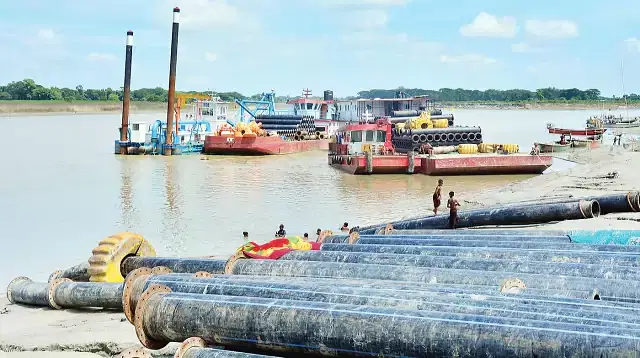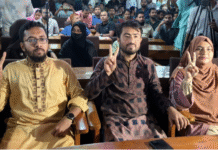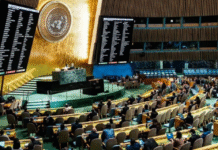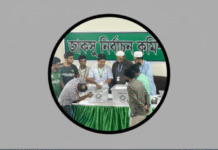Govt, influential quarters grab Puratan Brahmaputra land

The latest list of river and canal grabbers published by the National River Conservation Commission last month indicates that the Mymensingh city corporation and certain other influential quarters are among those who have grabbed most of the land belonging to the river, old Brahmaputra. The city corporation mayor, his brother and a freedom fighter have built up their establishments on this land along with several government offices and religious institutions.
The commission revealed that there are more than 2000 illegal structures on the river and canal land across the district, including 1500 in the sadar upazila alone.
Locals told the Prothom Alo correspondents that the district administration conducted an eviction drive in January and dismantled a number of houses on the encroached lands of old Brahmaputra. Before the eviction, the river had been dredged. The structures on the embankment, however, are yet to be removed.
According to the river conservation commission, Mymensingh city corporation owns seven buildings, kitchen markets, garages and ward 9 office on the occupied land. The office of Shamim Enterprise, a company belonging to the mayor Iqramul Huq and his brother Aminul Huq, is also located on the river land, the commission’s report says.
There is still a government health centre as well as a road and highway department office on the embankment. There is also a three-storey building owned by the Bangladesh Muktijoddha Sangsad (Central Command Council) The state-owned Rupali Bank has rented the first floor for its office. Former parliamentary publicity and rehabilitation secretary Bimal Pal told Prothom Alo, the government gave them the land for one taka in 1990 and the building was constructed with government funds.
Mayor Iqramul Huq said, no boundary was demarcated on the river Brahmaputra earlier and that is why the structures have been constructed. Although he claimed that he left the part of land that was allegedly occupied by his firm, the Prothom Alo correspondents saw vehicles parked there.
On the commission’s list there are a number of religious institutions including Kalu Shah Mazar, Buro Peerer Mazar, Falah Masjid, a Hindu temple, Loknath Ashram, Satsang centre and more there.
Earlier, in November 2015, the district administration started clearing the illegally occupied land, but later stopped. Then in December, the district administration and Bangladesh Water Development Board (BWDB) conducted a joint eviction drive.
More than 1,000 settlements had been demolished, but these were mainly slums on silted land, warehouses and markets. The structures on the embankment remained untouched. The river conservation commission chairman Mujibur Rahman Hawladar visited the area and asked the administration to start eviction immediately.
Mujibur Rahman said, the old Brahmaputra will also be dredged soon. No matter how powerful the grabber, he will not be spared, he added.
Bangladesh Inland Water Transport Authority (BIWTA) started four river dredging projects including Brahmaputra in July. An important task of this 30 billion taka project is to determine the boundary of the old Brahmaputra river.
Project director Rakibul Islam said, red flags will demarcate the boundaries on the both side of the river after removing illegal structures. The rivers and canals will be revived.
Deputy commissioner Mizanur Rahman told Prothom Alo, government institutions, individuals and organisations have been asked to remove the structures to free the river of encroachment. A special drive will be launched soon.
Dangerous level of pollution
Assistant professor at Bangladesh Agricultural University Sadekur Rahman conducted a study in 2019 on the quality of Brahmaputra river water. Comparing his findings with the water in Malaysia, he said no aquatic animal would survive in the water and it was not drinkable.
Speaking to Prothom Alo, convener of Mymensingh-based Brahmaputra Surakkha Andolan, a civic body to save Brahmaputra river, Abul Kalam said Mymensingh town centred on this river and had to be saved by any means.
The city corporation, business firms and industries dump their most of the waste into the river. The volume of daily waste amounts to about 89 tonnes, according to a 2018 estimate of the Asian Development Bank (ADB). ADB also forecasted that the amount would 116 tonnes in 2020. Besides, the residue of chemical fertilisers and insecticides are also being mixed with the river water.
Director of the Mymensingh divisional office of the environment department, Farid Ahmed, said no government organisation in the district, including the city corporation, WASA and Mymensingh Medical College Hospital, have their own waste treatment system or Effluent Treatment Plant (ETP). The industries also don’t have those either, he added.
He said time and again they urged and gave letters to the government organisations requesting to install ETPs. Private firms cite the example of government organisations if we create pressure on them, he said, adding that alongside dredging, the quality of Brahmaputra’s water should be protected.
There are around 1000 local and foreign industries in Bhaluka upazila. Most of them do not have any ETP. According to the river commission, Butterfly Manufacturing Company, Art Composite, K&K Industries and Kanthalia Fisheries set up firms grabbing the land of two tributaries of Puratan Brahmaputra.
The original Brahmaputra entered Bangladesh through Kurigram district and then entered Mymensingh via Jamalpur. But the course of the main river was changed due to a strong earthquake around 200 years ago leaving a branch, Puratan Brahmaputra, behind.
There are natural reasons too behind the river’s present condition. But pollution and encroachment are the main reasons of its gradual death.
* The report, originally published in the print edition of Prothom Alo, has been rewritten in English by Farjana Liakat and Shameem Reza









